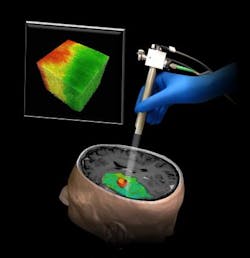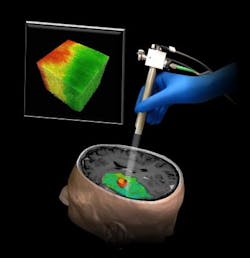OCT could enable brain tumor removal without ionizing radiation
Researchers at Johns Hopkins University (Baltimore, MD) have developed an optical coherence tomography (OCT) imaging technique that could provide brain surgeons with a color-coded map of a patient's brain that shows which areas have and do not have cancer.
Related: Photoacoustic imaging detects breast cancer without ionizing radiation
OCT operates on the same echolocation principle used by ultrasound scanners, but it uses light rather than sound waves to yield a higher-resolution image than does ultrasound. And unlike x-ray, computed tomography (CT) scans, or positron emission tomography (PET) scans, it delivers no ionizing radiation to patients.
A group led by Xingde Li, Ph.D., a professor of biomedical engineering, worked with Alfredo Quinones-Hinojosa, MD, a professor of neurosurgery, neuroscience, and oncology at the Johns Hopkins University School of Medicine and other collaborators. Carmen Kut, an MD/PhD student working in Li's lab, first built on the idea that cancers tend to be relatively dense, which affects how they scatter and reflect lightwaves. The team tried for three years to build their technique on this principle. Eventually, the researchers figured out that a second special property of brain cancer cells—that they lack the so-called myelin sheaths that coat healthy brain cells—had a greater effect on the OCT readings than did density.
Once they had found the characteristic OCT "signature" of brain cancer, the team devised a computer algorithm to process OCT data and, nearly instantaneously, generated a color-coded map with cancer in red and healthy tissue in green. "We envision that the OCT would be aimed at the area being operated on, and the surgeon could look at a screen to get a continuously updated picture of where the cancer is—and isn't," Li says.
So far, says Kut, the team has tested the system on fresh human brain tissue removed during surgeries and in surgeries to remove brain tumors from mice. The researchers hope to begin clinical trials in patients this summer.
Quinones-Hinojosa explains that MRI scanners designed to be wheeled over a patient on the operating table cost several millions of dollars each, and require an extra hour of operating room time to obtain a single image. By comparison, the team anticipates that the cost of an OCT-based system would run in the hundreds of thousands of dollars.
The system can potentially be adapted to detect cancers in other parts of the body, Kut says. She is working on combining OCT with a different imaging technique that would detect blood vessels to help surgeons avoid cutting them.
Full details of the work appear in the journal Science Translational Medicine; for more information, please visit http://dx.doi.org/10.1126/scitranslmed.3010611.
Follow us on Twitter, 'like' us on Facebook, connect with us on Google+, and join our group on LinkedIn

